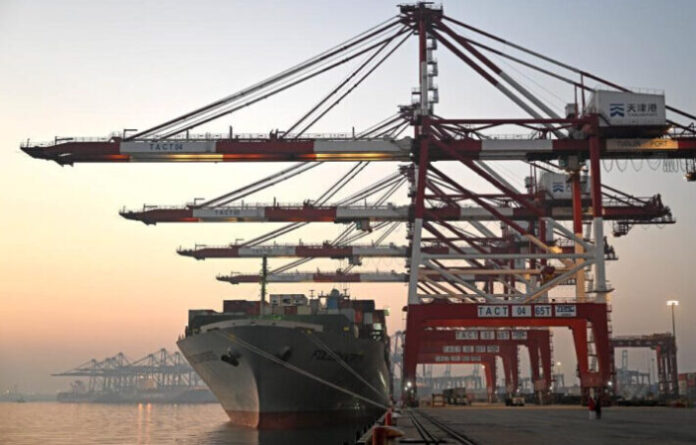
-
ASEAN-China ports benefitting from RCEP perks as Philippines and Myanmar bide their time on joining the world largest trade pact
-
Fifteen months into the regional agreement, Chinese and ASEAN ports as well as logistics services are seeing robust business from RCEP
-
Beibu Gulf Port plays a pivotal role in providing maritime transportation with large cargo volumes and lower costs
As the Philippines and Myanmar drag their feet on joining the Regional Comprehensive Economic Partnership, ASEAN and China ports reap benefits of RCEP, the world’s biggest regional free trade agreement.
The Philippines has yet to submit its RCEP ratification documents for a targeted joining in June. Myanmar, meanwhile, is still trying to crush a civil war against its new military rulers.
RCEP benefits are lower trade barriers, better market access, more streamlined customs procedures, and tariff concessions from trading partners.
The biggest winners from increased trade generated by the 15-month-old pact appear to be the gateways of China – the world’s largest export market and the Philippines’ top source of imported goods.
An example is Beibu Gulf Port in Southern China’s Guangxi Zhuang Autonomous Region, which logged the highest year-on-year growth in the first two months of 2023, moving 1.08 million TEU during the period – a 23.5% increase since last year.
In late March, cargo ships carrying 18 tons of orah mandarin left Qinzhou Port, one of three comprising South China’s Beibu Gulf Port. It was the first batch of the sweet fruit backed by local cold chain logistics and to be exported by sea, reaching Thailand in about eight days, Xinhua said.
China’s fruit exports have risen sharply with the development of cold chain logistics. Since January, Beibu Gulf Port has shipped about 2,850 twenty-foot equivalent units (TEUs) of freezers and 500 TEUs of fresh fruits, said He Jian, a logistics business manager at Beibu Gulf Port.
Since 2022, Beibu Gulf Port has launched 34 specific foreign trade routes to RCEP countries and plans to develop more goods source markets in countries like Thailand, Cambodia, and Vietnam. Last year, Chinese goods to RCEP countries shipped via the trade corridor grew 9.7% y-o-y to 69,000 TEUs, Xinhua reported.
Another RCEP beneficiary is Tianjin Port in North China’s Tianjin. On April 11, the port handled 5.05 million TEUs in the first three months of 2023, up 9.09% year on year, according to a caption story by Xinhua.
Tianjin is so far the first of 12 major Chinese ports to report its container cargo performance for the January-March period.
From January to February 2023, Chinese ports reported container throughput of 44.1 million TEU, up by 1.3% compared to the same period in the previous year. Shanghai, however, declined 8.6% y-o-y with 7.46 million TEUs in January-February.
Meanwhile, Beibu Gulf Port is seeing strong business from nearby Association of Southeast Asian Nations member-states that are RCEP agreement members.
“There are various transport means for Thai durians to enter the Chinese market. The increasingly convenient transportation and logistics network allows more ASEAN commodities to enter China and share market opportunities,” Xinhua quoted Nisachol Thaithong, a Thai trader, as saying.
Xinhua said credited the robust cross-border trade to the constant construction of the New International Land-Sea Trade Corridor, a trade and logistics passage jointly built by provincial-level regions in western China and ASEAN member countries.
Beibu Gulf Port plays a pivotal role in providing maritime transportation with large transport volumes and lower costs, efficiently helping meet consumption needs, the report said.
Huang Jiangnan, head of Qinzhou Port’s east railway station, said more varieties of western China’s specialties, including goji berry products from Ningxia, nuts from Xinjiang, and tea from Guizhou, have been exported through the corridor’s rail-sea intermodal services over the years.
The benefits of RCEP trade have made the once little-known local signature products the engines of China’s foreign trade growth in ASEAN, especially after the trade pact took effect on January 1, 2022.
The pact also facilitated China’s imports of commodities such as Thai glutinous rice, Vietnamese basa fish, and Cambodian bananas.
On March 22, more than 5,700 cattle arrived at Qinzhou Port after a 17-day voyage from Australia’s Portland Port. The cattle be quarantined for 45 days before being sold to help improve breeding or milk production across China.
With booming trade, the total number of train trips via the corridor’s rail-sea intermodal service surged from 178 in 2017, when regular train service began, to 8,820 last year. More high-end, higher-value-added products, such as automobiles, are riding high on the trade corridor.




